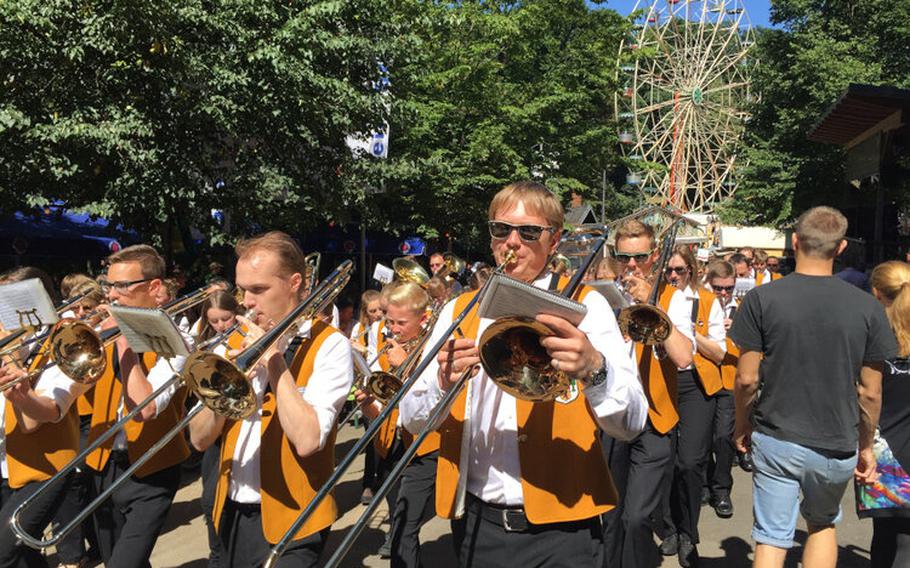
Annafest in Forchheim, Germany, celebrates St. Anne. The festival continues through Aug. 4. (annafest.bayern)
A countless number of Europe’s fests can trace their roots to religious holidays honoring saints and holy figures from throughout the centuries. Even when the holy figure being honored no longer stands front and central to the celebrations, it can be interesting to piece together the connection between the partying and the person.
Annafest in Forchheim, Germany: Saint Anne is considered to be the mother of the Virgin Mary and grandmother of Jesus Christ. She and her husband Joachim were long unable to conceive a child, but they were rewarded for their perseverance and faith with the birth of a baby girl. Saint Anne is the patron saint of grandmothers, pregnant women, lace makers, seamstresses and many others. The day chosen by the Roman Catholic Church to jointly honor her and her husband is July 26.
The city of Forchheim, located in Bavaria’s Franconia region, has been holding a folk festival by the name of Annafest since 1840. Pilgrims traveling to a chapel dedicated to Saint Anne on July 26 would pass through the Kellerwald, an oak-forested area where many beer cellars were built to make sure the beer would stay as cool as possible. Today’s Annafest is an 11-day celebration known and loved for its exceptional woodsy setting, four local breweries creating a special Bock beer expressly for the occasion and traditional fare including sausages and grilled meats. The usual mix of tame and scary rides and games of skill and chance is found here too. The Annafest continues its 2025 run through Aug. 4. Forchheim is located roughly 25 miles north of Nuremberg. Online: annafest.bayern
Saint Lawrence Day in Florence, Italy: tradition holds that Saint Lawrence, or San Lorenzo in Italian, was one of seven deacons of the early Christian church in Rome. On Aug. 6, 258 A.D., Emperor Valerian ordered six of these clergy members, including the pope, to be executed. San Lorenzo was given three days to collect the treasures of the church, and upon giving them to the emperor, his life was to be spared. San Lorenzo chose instead to distribute the church’s wealth to the poor, which earned him martyrdom by being roasted over hot coals atop a gridiron. A quip to his tormentor about being well-done on one side led him to be named a patron saint of not just cooks and firemen but comedians too. His feast day is celebrated on Aug. 10.
Florence celebrates San Lorenzo, one of its two patron saints, on Aug. 10 with a historical procession of costumed marchers, a mass at the basilica bearing the name of the saint, a concert and the distribution of pasta and watermelon. The parade sets off from the Palagio di Parte Guelfa at 9:45 a.m., and the free meal is handed out at the square in front of the basilica at 8:30 p.m. It’s traditional to top off the evening with eyes turned to the skies in search of the shooting stars of the Perseids meteor shower. Online: tinyurl.com/22pnvuxv
Sant Bartameu in Sitges, Spain: Bartholomew is one of the 12 apostles who traveled with Jesus during his three-year ministry. Following Jesus’ Ascension, he is believed to have served as a missionary to lands in the area of modern-day India, Turkey and Armenia. Various accounts of his martyrdom exist; one version is that he was flayed as punishment for converting a king to Christianity. The patron saint of tanners, bookbinders, butchers and shoemakers, his feast day is celebrated on Aug. 24.
Sitges, a lively coastal resort some 25 miles southwest of Barcelona, celebrates one of its two patron saints with the city’s biggest bash of the year, the Festa Major de Sant Bartomeu, on Aug. 23 and 24. Elements of the festivities include costumed figures of giants and devils running in the streets, folk dancing, and the lighting of a fire castle on La Fragata beach. A grand display of fireworks is set off late on the evening of Aug. 23. Online: sitgesfestamajor.cat
Feast of Saint Marinus in San Marino: tradition holds that Marinus was a stonemason born on what is now the island of Rab in Croatia around 275 A.D. To flee persecution for his Christian beliefs, he moved to the area near Rimini, eventually settling into a hermit’s life on Monte Titano. This mountain is the highest peak in the Republic of San Marino, considered the world’s oldest extant sovereign state. Surrounded entirely by Italy, the world’s fifth-smallest nation in terms of land mass has a population of about 34,000.
The feast day of San Marino, celebrating the origin of the Republic in 301, is carried out with great pomp on Sept. 3 of each year. Following the 10 a.m. Mass, the relics of the saint are paraded through the streets, and at 2:30 p.m., a historical parade with costumed marchers sets off from the Porta San Francesco. The crossbow tournament featuring shooters from the nation’s nine districts at 3:30 p.m. is followed by a concert by the country’s military band, and a grand display of fireworks is shot off at 11:30 p.m. Online: tinyurl.com/3k9e4jff